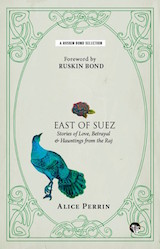East of Suez: Stories of Love, Betrayal & Hauntings from the Raj
Alice Perrin
|
“One of the many lessons that the great Mother India instils into the hearts of her white foster children is to sympathise with one another’s troubles and misfortunes however trivial or however serious” (p 133). With these words begins the story “The Summoning of Arnold,” a short story in Alice Perrin’s collection of short stories, East of Suez. And, as per her literary convictions, Perrin did sympathize with her fellow domiciles, both native and otherwise. Not covertly or even blatantly, but through a finesse of expression that is at once distinctly, and brilliantly, evocative of colonial and pastorally ‘native’. The anthology, first published in 1901, collects fourteen tales of estrangement, yearning for homeland, intrigue, mystery, heartbreak and myriad other emotions that belie the slim size of the volume. Alice, born in 1867, a decade after the Mutiny, was the daughter of General John Innes Robertson of the Bengal Cavalry. Unlike Kipling, whose works on India are recollections of his early childhood spent in India, Alice’s stories were founded upon her return to India in 1886, when she was married to Charles Perrin, a civil engineer in the India Public Works Department, and stayed for the next sixteen years, a period which also witnessed the publication of East of Suez. The collection, first published in 1901, has been reprinted in its current visage—startlingly appealing and visually complimenting. It is perhaps the profession of her husband that forms the scaffolding to the first story in the volume, “Beynon, Of the Irrigation Department,” which also displays the themes that recur across her stories. The description of Patakri, the setting for the story, invokes a historical poignancy perhaps best attached with the senses of rural colonial history, a poignant repository of images that is consistent with the other stories:
The setting is poetic and remarkably in keeping with how an occidental might view oriental locales with its romanticizing of their colonial abode, but the evocative beauty far exceeds the punctilious arrangements that characterise other colonial narratives. Notable are also Perrin’s tales of the supernatural—a theme which underpins her core set of beliefs and associations with India. Ruskin “You don’t have to believe in ghosts in order to enjoy a ghost story. And while a good ghost story may not turn you into a believer of the supernatural, it can make you ponder upon the mysteries of human existence, and raise the possibility of another layer of life outside our material selves—something of the soul-force, the aura of a person that lingers on after the body is no more” (Ruskin Bond, ‘Introduction’ to A Face in the Dark and Other Hauntings: Collected Stories of the Supernatural, New Delhi, Penguin, 2004, vii). It is this presence of the person beyond the material form, not as a visible manifestation of the spirit always, but one which has certain distinct rationales. Instead of an exotic wonder at the supernatural possibilities, Perrin approaches the poetic horror of the continuation of memories and longings after death in such stories as “Caulfield’s Crime,” a story that appropriates oriental religious-supernatural myths more than the others. “The Summoning of Arnold” is also a story of an excess of longing of the eponymous character for his wife that eventually results in his own death, “In the Next Room.” “The Belief of Bhagwan, Bearer” also offers a purposive view of the relationship between a servant and his master. “Chunia, Ayah” is a tragic tale of a child’s return after death that results in, although it is not exerted, an avengement. The feverish depression of loneliness, the solitary deceptions of self-sufficiency are the staple of Perrin’s works, which look into the everyday lives of the colonial diaspora. The recurrent onomatopoeic reverie of the ‘brain fever bird’ that makes appearance on multiple occasions is a harking back to the shrill despair of separation from one’s own country. The distinction being that Perrin does not allow the despair to overpower her, but instead channels it into a creative nostalgia that enables her to see herself and others like her prismatically besides being an excellent observer of the native population. Perhaps the literary term that could be attributed to this symptom issehnsucht, a German word which transliterates to an ‘intense longing’ particular to those who either yearn for a utopic non-place or mythicize their homeland to the extent of rendering it into a similar psychological utopia, a haven that might not exist in reality. Sehnsucht is ideal to sum up the nature of Perrin’s stories also because it involves profound, often simultaneously negative and positive feelings—an attribute that is manifest starkly in the present crop of stories. Marriage is another important issue in these stories, as it is in the largesse of Victorian fiction—and in a similar fashion Perrin also describes discordant marital states, inattentive husbands, frustrations, despairs, heartbreaks and desolations. Similarly, there are intrigues, surprises and affections, and tales of husbands so uxorious as to be manic with despair upon separation from their wives—in short, the entire spectrum of the dynamics of marriage instead of the description of any one perspective. The moral strain is rather pronounced in Perrin’s narrative fabric, but that is not to say that it is an attribute to be denounced. Instead, what we have in these stories is the ability to weave a tale without the excessive moral policing akin to Puritanism or the hedonistic carelessness that characterised certain other works of colonial fictioneering. Extending this sense, when Perrin discusses relationships between master/mistress and servant, there is a marked absence of absolutism in the subaltern-status given to the native employee. Although villainy and supernatural orientalising are attributes often placed on the servants, the same has also been rendered for the colonisers at numerous points in the narratives. Similarly, their presence is often reassuring and is an attempt to fend off the hostilities and animosities of an alien nation. Perrin writes of causality—not the cause and effect of a physicist’s imagination but the religious philosophism of a latent Indianness that espoused effects as propinquitous upon the incumbent as well as others. This is the East speaking through its Western spokesperson. Whether it is the psychological abjection of “A Perverted Punishment” or the spiritual flair of violent predicaments in “‘In the Court of Conscience’” or “The Fakirs’ Island”, the stories are equally passionate in representing the lives of the settlers and administrators, subtly induced with a local colour—Perrin flawlessly effected the chiaroscuro that her contemporaries sometimes convoluted merely by express bias of some form or the other. Perrin, on the other hand, takes every form of existence as a commonplace incident. For instance, the murder of an English officer and her wife by the natives during the Mutiny is not as grossly represented as sensational accounts of the time would purport to, despite the story concerned, “In the Next Room”, being one of a haunting. And especially one that ends quite violently. Colonial narratives of India have generally relied on the issuance of, what Said refers to as “[a] comparative or, better, a contrapuntal perspective” which is necessary “in order to see a connection between coronation rituals in England and the Indian durbars of the late nineteenth century” [Said, Edward W. 1994 (1993), Culture & Imperialism, London, Vintage, 36] – in other words, two discrepant cultural artefacts. To comprehend the nature of such colonial narratives, Said further suggests, “we must be able to think through and interpret together experiences that are discrepant, each with its particular agenda and pace of development, its own internal formations, its internal coherence and system of external relationships, all of them co-existing and interacting with others” (ibid). Alice Perrin’s stories too should be read from a similar cultural and theoretical perspective that brings together the varia that is divided generally along dualistic lines of ‘coloniser’ and ‘native’. The volume is indebted to Ruskin Bond’s ‘pinching’ it from a purportedly haunted bungalow he had visited. And on this rare instance, I am overtly glad on the act of book-theft for it has led to my experiencing Perrin’s amazingly poignant tales firsthand. To quote Bond:
Perhaps to add my feeble recommendation to Ruskin Bond’s glorious portrayal, I believe Alice Perrin’s stories should be read by all and sundry, if not for an alternate view of the nation’s colonial past then at least for the lessons in humanity and humility that the reader takes away despite no manifest moralising efforts of the author. Perrin succeeds in portraying a virile and potent historical imaginary that is acute, apt, accurate and sympathetic, dispossessed of the national instinct of a Kipling or the philanthropy of Forster. Her writing is crisp, clear and vivid, and does not require the virulent desiccation of antiquity to be made into a remarkable literary enterprise. This is prose that is instantly endearing, which is doubly disconcerting considering this reviewer has spent a quarter of a century of his life remaining entirely, and wistfully, oblivious to the presence of Perrin’s superlative works. It is only to be hoped that Perrin’s works are published in equally wonderful and accessible editions such as this for the general reader. Subashish Bhattacharjee | Mar-April 2016 | Muse India
|


 Alice Perrin
Alice Perrin